Posts for: picpiper
Sep 9, 2012 19:06:48 #
amyinsparta wrote:
got to agree. Beauty is where you find it and how you create it. I don't think God minds a little photoshopping now and then! :mrgreen:
pettigkr wrote:
Great link. Genius work, in my opinion.
What's wrong with creativity in Photoshop? I remember burning and dodging, as well as double exposures in the black and white days. The finished print was very different than the "reality" that was captured on the film.
Beauty is beauty.
What's wrong with creativity in Photoshop? I remember burning and dodging, as well as double exposures in the black and white days. The finished print was very different than the "reality" that was captured on the film.
Beauty is beauty.
got to agree. Beauty is where you find it and how you create it. I don't think God minds a little photoshopping now and then! :mrgreen:
Indeed - creative genius. Interesting minute and half video on how he did one here: http://erikjohanssonphoto.com/work/selfactualization/
Sep 9, 2012 03:12:40 #
jan wrote:
Camera noise makes photos look grainy and not smooth. I think it is something that happend when one chooses the incorrect settings for the situation. Probably somebody else could explain it better...thanks for reading my question though. Jan
Bob K. wrote:
I have heard the term ''camera noise'' used here on several occasions.
Please tell me what this is?
Thank you,
Bob K.
Southern Indiana
Please tell me what this is?
Thank you,
Bob K.
Southern Indiana
Camera noise makes photos look grainy and not smooth. I think it is something that happend when one chooses the incorrect settings for the situation. Probably somebody else could explain it better...thanks for reading my question though. Jan
It's not so much "incorrect" settings as it is settings that are manually or automatically set so that you can get an "acceptable" photo instead of no photo at all. Digital camera sensors are basically electronic amplification devices. The noise-free quality of a photo is dependent on the signal-to-noise ratio of the system at the time of the photo.
Picture (mentally) an old radio tuner. If you are not on a station and turn the volume way up you hear noise commonly called static. If you leave the volume up and tune to a nearby station with a strong signal you hear very clear sound and have to turn the volume (amplification) down to a comfortable listening level. Then you tune to a different, distant station with a weak signal. With your comfortable listening volume you can just tell there are words coming through. You turn up the volume and you can understand what is being said, but the static noise increases proportionately. The other important factor in this analogy is that if you really wanted to bring in those distant stations you (or your Dad) put a huge motorized antennae on top of the tallest mast he could get away with in the neighborhood.
So that, in a nutshell is how your digital camera works. Strong signals (good full daylight) fall onto the sensor (which is both a "light antennae" and an electronic signal amplifier) set to normal amplification levels (ISO 100 - 200) and you get the best picture your camera is capable of. Now when the signal weakens with less light, you have to crank up the ISO/amplifier. But in doing so you are also amplifying the noise in the system.
If your 10 megapixel digital camera sensor (antennae) is smaller than a fingernail you are sometimes not even able to get a smooth noise-free image at ISO 100, let alone 200 or 400.
On the other hand, if your 10 megapixel camera sensor is "full frame" sized you can crank the ISO (amplification) up to 6400 and beyond and still have very little noise. The strength of the signal is directly related to the size of the sensor.
Hope this helps a little.
Sep 5, 2012 04:41:51 #
Wahawk wrote:
Guess it is time to quit following this thread. It is getting too much attention and those who love trashing anything but dSLR are coming out.
Good bye!
Good bye!
My my ... what an odd thing to say. I have really been enjoying this thread with the pictures and comments by current and prospective owners of the SX40 (and SX30). Went back and reread the whole thing and for the life of me can't find anyone who is "trashing anything but dSLR".
I did include a D5100 image in my spider shots to allow anyone who is interested enough to crop out the spider and see how surprisingly similar the detail quality is when you are doing real world "get the shot before it changes" type of shooting and presenting them in web-friendly sizes.
But then again, those images were resized and compressed. If you do pixel-peeping at high zoom levels, you simply can't get around the physics and electronic and optical properties that allow larger sensors to usually yield noticeably better images. That is simply a fact - and the whole sub-topic of sensor sizes was in response to a question DJ (who kicked this whole topic off) asked.
Oh rats ... now it's sounding like I'm "trashing anything but dSLR".
I have 5 PowerShots and love them all - never leave the house without my SD770 or Elph 310 in my pocket. When I'm out with the grandkids I know I could get "better" pictures with the Nikon, but it is just so much easier to grab the SX30. And as many have demonstrated in this thread, the SX40/30s can produce great images.
Sep 4, 2012 03:35:17 #
jerryc41 wrote:
"Making life simpler - through electronics." :D
picpiper wrote:
A few more pictures of the full backup rig based on the Samsung Galaxy SIII. (Since the SIII only supports 5 external storage devices you don't NEED a 10 port hub.)
"Making life simpler - through electronics." :D
Yes, valid observation. Certainly lots of little things to lose track of. But since I already had the phone, the hub, the SD cards, the USB sticks and the hard drive, I was blown away by the fact that I could order the $4 OTG adapter, hook things up and not have to lug around my 17" notebook to offload and backup while travelling.
Sep 4, 2012 03:02:25 #
WxGuesser wrote:
quote=haroldross br The sensor in the SX40 is 1/... (show quote)
Go here
https://en.wikipedia.org/wiki/Image_sensor_format to see sensor size chart.
There is a chart at the top that shows the relative sizes and another half-way down the page (past all the equations) that shows actual dimensions.
Sep 3, 2012 21:13:44 #
djmills wrote:
Keep the comments & photos coming. This conversation has been one of the most enjoyable threads I have followed. DJM
OK - some of the talk about macro vs. supermacro in the SX30/40 and S3/5 got me curious enough to do a few comparison shots after noticing a spider preparing his dinner on a tomato plant. These are quick "real world", hand held shots - took two shots with each camera and chose the sharpest to post. No cropping. One is with an S3 in supermacro mode, one an SX30 in macro with the 1.7 digital zoom enabled and one with a Nikon D5100 with the 18-55 kit lens at 55mm. Can you tell them apart without looking into the EXIF info?
Photo 1

Photo 2

Photo 3

Sep 3, 2012 18:19:08 #
A few more pictures of the full backup rig based on the Samsung Galaxy SIII. (Since the SIII only supports 5 external storage devices you don't NEED a 10 port hub.)



Sep 1, 2012 18:06:37 #
Mogul - your explanation of what you are doing really helped me understand the context.
Remember that it was claimed that Willie Sutton said "because that's where the money is!" when asked why he robbed banks. You should ask the card manufacturers and/or their American distributors for some small capacity cards. Send them a picture of you and your locomotive and the line of visitors waiting. Maybe include a link to this UHH thread. Tell them you would be happy to give the cameraless visitors a business card saying "These memories of today's visit are courtesy of XXXXXXX". (Preferably supplied by them along with the SD cards).
I just Googled "public relations director SanDisk" and the first hit took me to his LinkedIn page. I suspect less than an hour of Googleing would turn up at least 10 or 12 people to ask directly.
I remember that several of my Canon cameras came with a 16 or 32 MB SD card - which reviewers always ridiculed because you could only get 6 or 8 pictures on them. There must be a trove of those in some warehouse somewhere. (You should probably email the request to camera company PR folks too.)
It just seems that someone in one of the camera or SD card companies would recognize the PR value of what you are trying to do.
Good luck.
Remember that it was claimed that Willie Sutton said "because that's where the money is!" when asked why he robbed banks. You should ask the card manufacturers and/or their American distributors for some small capacity cards. Send them a picture of you and your locomotive and the line of visitors waiting. Maybe include a link to this UHH thread. Tell them you would be happy to give the cameraless visitors a business card saying "These memories of today's visit are courtesy of XXXXXXX". (Preferably supplied by them along with the SD cards).
I just Googled "public relations director SanDisk" and the first hit took me to his LinkedIn page. I suspect less than an hour of Googleing would turn up at least 10 or 12 people to ask directly.
I remember that several of my Canon cameras came with a 16 or 32 MB SD card - which reviewers always ridiculed because you could only get 6 or 8 pictures on them. There must be a trove of those in some warehouse somewhere. (You should probably email the request to camera company PR folks too.)
It just seems that someone in one of the camera or SD card companies would recognize the PR value of what you are trying to do.
Good luck.
Aug 31, 2012 02:03:21 #
Mac wrote:
quote=SanStokes I have always fought with this di... (show quote)
Not quite sure what you mean by "& flashdrive". Is this internal or external to laptop? Bottom line is that any computer files you value should be backed up on at least two drives that are located in different places. A relatives computer and external drive were stolen. Fortunately, there were backup DVDs of photos that were not taken. Houses burn down. Drives die.
Here's what we do: I keep all data files on our two machines on external drives (eSATA cables NOT USB). Every week or two both external data drives get copied to portable "pocket" hard drives that stay in our "In and Out" box next to the front door. Whenever we go out we grab the box. When we are going to be away for more than a couple of days I disconnect the main external data drives and hide them somewhere. We also keep some important stuff in the "cloud" with SugarSync and DropBox. It sounds like overkill, but in my 30 years of network and computer support experience I've had to deal with all typical data loss scenarios - they're best avoided.
So... go ahead and format as long as you have a backup/redundancy/disaster plan in place.
Aug 31, 2012 01:22:30 #
barbuck99 wrote:
I've been very happy with my SX40 except for the macro mode, specifically focusing of extreme close-ups (insects, etc.). My previous camera, an S5IS, has a SuperMacro mode that puts the SX40 to shame. I still use it for most of my macros, despite its noisier images.
I'm a generation behind you - love my SX30 but use the supermacro on my S3IS for those really close shots.
Aug 28, 2012 22:51:58 #
I have always travelled with a laptop for backup and review purposes. I will no longer have to do so because I have been exploring the absolutely amazing capabilities of my new Samsung Galaxy SIII smartphone. Before I get to the how-to (and entice you to read what is probably going to be a longer than usual post) here are some of the things you can do with an SIII, a couple of special connectors and adapters and things most of us already have (SD cards, USB storage sticks, USB hubs, portable hard drives):
1) Put your camera SD card into a carrier with a USB plug, plug the carrier into an OTG ("On the Go") cable and transfer your photos onto a microSD card (up to 64GB for sure, probably 128GB too) that lives inside the phone.
2) Configure the phone to automatically or manually copy your pics to the "cloud" through DropBox, SugarSync, SkyDrive or wherever you have storage set up. They can go directly from the camera SD card at the end of the OTG cable or from the "backups" that are on the phone microSD. (Even from a portable hard drive - details below.)
3) You can also plug a USB external hard drive into the OTG cable to move files from the drive to the phone and vice versa.
So if you have been following along you are probably thinking, "You mean I have to plug the camera card into that phone OTG thingy, copy pictures to the phone, unplug the camera SD card, plug in a hard drive then copy stuff from the phone to the drive??!!" Yes, that could be a hassle. Here's the really cool thing:
4) You can plug a POWERED USB hub into the OTG cable and have access to as many hard drives and SD cards as you have carriers and hub ports available! So with the USB hub plugged into the phone with camera SD card in one port and a portable USB hard drive (or USB sticks or SD cards) in another port you can copy files directly from the camera card to the hard drive or other USB storage media. You can even connect a Bluetooth keyboard/mouse to the SIII with a Bluetooth dongle in the hub!
So you have almost completely replaced the laptop functions with the SIII. It has a gorgeous 4.8" screen, but even with zooming and panning it is a bit limiting. The icing on the cake:
5) With a different adapter plugged into the SIII you can connect it to any LCD TV or computer screen that has HDMI input to see your photos and movies that are in the phone (or that you can stream with Netflix, Hulu, etc. - but I digress). Since there is only one microUSB port on the phone you can either manage files on external devices OR output to an HDMI screen, but not both at the same time.
And the final cherries on top:
6) The SIII has a fairly decent camera and lots of camera apps. Be sure to check out Sun Surveyor and if you're travelling to foreign lands with any newer Android phone you should install Google Translate.
Before I get to some of the nitty-gritty and gotchas (there are a couple) you might want to search for and watch a Youtube video that can be found with this string:
" Samsung Galaxy S3: Connectivity demo - USB OTG, MHL, bluetooth keyboards/mice, games "
by NZtechfreak at AndroidNZ.net. It is a long video and all the good stuff (for photographers) is in the first 7 minutes. After that he gets into all the game controllers and emulator software the SIII supports.
Hardware:
1) OTG - See picture for the OTG connector that works for me and source.
2) HDMI cable adapter - "Adapter HDMI EPL-3FHU for Samsung Galaxy s3" IMPORTANT make sure it is for SIII - the pins are different from the adapters for older Samsung phones.
Misc. Notes and gotchas:
SD CARDS AND HARD DRIVES
Any device that you want the SIII to see through the OTG adapter MUST be in FAT32 format. That is how SD and microSD cards are formatted up to 32GB. SD/microSD cards 64GB and above and the high capacity external hard drives (500GB and above) are exFAT formatted. If you want to put a 64GB exFAT formatted microSD into the SIII it will appear to work until you get to a certain threshold, then file corruption problems start to appear. (All the gory details are here: http://forum.xda-developers.com/showthread.php?t=1698672 - BTW - I'm rajamar on that forum).
So if you do want to put a 64GB microSD in an SIII use this tool to format it from a Windows machine: http://www.ridgecrop.demon.co.uk/index.htm?guiformat.htm
I also had to use the above guiformat tool to reformat a Toshiba Canvio 500GB external hard drive that came with exFAT formatting.
POWER
If you watched the AndroidNZ.net video you saw the SIII dealing directly with the external Seagate hard drive that did not have any external power applied. This did not work with my 500GB Toshiba Canvio. The drive light came on, but there was no spinning sound, just head clicks. I had to run it through a powered hub.
USB hubs
Save yourself frustration and get a good powered hub. There are a lot of cheap options out there, but my experience and the reviews prove the low price is balanced out by high frustration. I have and recommend this: Plugable USB 2.0 10 Port Hub (with Power Adapter) at Amazon. It will even charge the phone while transferring files.
I know this is a lot to throw out all at once. But think about how truly remarkable this really is: with a cell phone, a $4 OTG adapter, a few USB storage devices of any capacity, a portable hard drive and powered USB hub you can have as much backup redundancy as you want including painless backup to the cloud while travelling.
If you're a photographer looking for a new or replacement phone you should check out the SIII - all carriers have them. One last note regarding carriers: if you are going to be sending hundreds of megabytes to the cloud pay attention to the data plan.
1) Put your camera SD card into a carrier with a USB plug, plug the carrier into an OTG ("On the Go") cable and transfer your photos onto a microSD card (up to 64GB for sure, probably 128GB too) that lives inside the phone.
2) Configure the phone to automatically or manually copy your pics to the "cloud" through DropBox, SugarSync, SkyDrive or wherever you have storage set up. They can go directly from the camera SD card at the end of the OTG cable or from the "backups" that are on the phone microSD. (Even from a portable hard drive - details below.)
3) You can also plug a USB external hard drive into the OTG cable to move files from the drive to the phone and vice versa.
So if you have been following along you are probably thinking, "You mean I have to plug the camera card into that phone OTG thingy, copy pictures to the phone, unplug the camera SD card, plug in a hard drive then copy stuff from the phone to the drive??!!" Yes, that could be a hassle. Here's the really cool thing:
4) You can plug a POWERED USB hub into the OTG cable and have access to as many hard drives and SD cards as you have carriers and hub ports available! So with the USB hub plugged into the phone with camera SD card in one port and a portable USB hard drive (or USB sticks or SD cards) in another port you can copy files directly from the camera card to the hard drive or other USB storage media. You can even connect a Bluetooth keyboard/mouse to the SIII with a Bluetooth dongle in the hub!
So you have almost completely replaced the laptop functions with the SIII. It has a gorgeous 4.8" screen, but even with zooming and panning it is a bit limiting. The icing on the cake:
5) With a different adapter plugged into the SIII you can connect it to any LCD TV or computer screen that has HDMI input to see your photos and movies that are in the phone (or that you can stream with Netflix, Hulu, etc. - but I digress). Since there is only one microUSB port on the phone you can either manage files on external devices OR output to an HDMI screen, but not both at the same time.
And the final cherries on top:
6) The SIII has a fairly decent camera and lots of camera apps. Be sure to check out Sun Surveyor and if you're travelling to foreign lands with any newer Android phone you should install Google Translate.
Before I get to some of the nitty-gritty and gotchas (there are a couple) you might want to search for and watch a Youtube video that can be found with this string:
" Samsung Galaxy S3: Connectivity demo - USB OTG, MHL, bluetooth keyboards/mice, games "
by NZtechfreak at AndroidNZ.net. It is a long video and all the good stuff (for photographers) is in the first 7 minutes. After that he gets into all the game controllers and emulator software the SIII supports.
Hardware:
1) OTG - See picture for the OTG connector that works for me and source.
2) HDMI cable adapter - "Adapter HDMI EPL-3FHU for Samsung Galaxy s3" IMPORTANT make sure it is for SIII - the pins are different from the adapters for older Samsung phones.
Misc. Notes and gotchas:
SD CARDS AND HARD DRIVES
Any device that you want the SIII to see through the OTG adapter MUST be in FAT32 format. That is how SD and microSD cards are formatted up to 32GB. SD/microSD cards 64GB and above and the high capacity external hard drives (500GB and above) are exFAT formatted. If you want to put a 64GB exFAT formatted microSD into the SIII it will appear to work until you get to a certain threshold, then file corruption problems start to appear. (All the gory details are here: http://forum.xda-developers.com/showthread.php?t=1698672 - BTW - I'm rajamar on that forum).
So if you do want to put a 64GB microSD in an SIII use this tool to format it from a Windows machine: http://www.ridgecrop.demon.co.uk/index.htm?guiformat.htm
I also had to use the above guiformat tool to reformat a Toshiba Canvio 500GB external hard drive that came with exFAT formatting.
POWER
If you watched the AndroidNZ.net video you saw the SIII dealing directly with the external Seagate hard drive that did not have any external power applied. This did not work with my 500GB Toshiba Canvio. The drive light came on, but there was no spinning sound, just head clicks. I had to run it through a powered hub.
USB hubs
Save yourself frustration and get a good powered hub. There are a lot of cheap options out there, but my experience and the reviews prove the low price is balanced out by high frustration. I have and recommend this: Plugable USB 2.0 10 Port Hub (with Power Adapter) at Amazon. It will even charge the phone while transferring files.
I know this is a lot to throw out all at once. But think about how truly remarkable this really is: with a cell phone, a $4 OTG adapter, a few USB storage devices of any capacity, a portable hard drive and powered USB hub you can have as much backup redundancy as you want including painless backup to the cloud while travelling.
If you're a photographer looking for a new or replacement phone you should check out the SIII - all carriers have them. One last note regarding carriers: if you are going to be sending hundreds of megabytes to the cloud pay attention to the data plan.
Typo - SII should be SIII
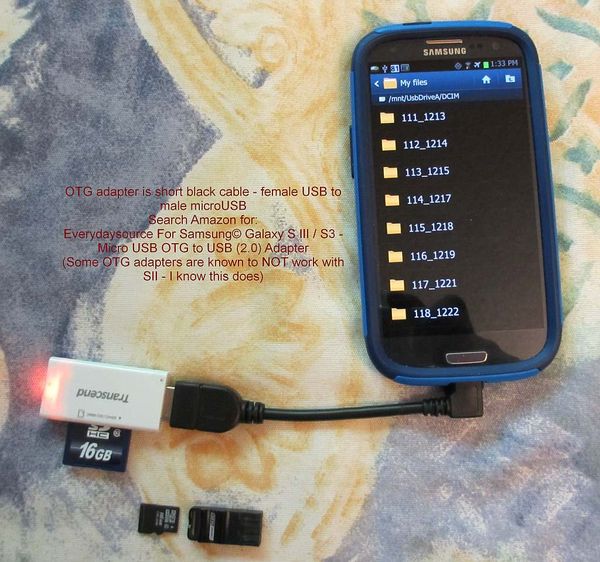
Aug 22, 2012 14:36:52 #
djmills wrote:
I shot this at F8, 1/50 sec, ISO 200. Handheld, leaning across the top of my car for stability.
KR40 wrote:
Would you mind sharing your settings used to get moon shot with SX 40 or SX30? Thanks
I shot this at F8, 1/50 sec, ISO 200. Handheld, leaning across the top of my car for stability.
WOW - that's great! I tried some moon shots when I first got my SX30 that I didn't like at all. Going to have to have another go at it.
Aug 20, 2012 22:19:22 #
Scoutman wrote:
quote=djmills If you own an SX 40, just log in an... (show quote)
CHDK is a wonderous thing! I have used it on my SD770, S3 and SX30. Here's a few things you should know:
1) It is not really a hack - it does not replace the camera's operating system. It rides on top and provides dozens of nifty capabilities. You just put the CHDK files on your SD card, turn on your camera in view mode, access the camera menu and select "Update firmware". I KNOW, I KNOW --- this sounds drastic, but all you are doing is loading the CHDK software into memory. It is NOT updating your firmware.
2) Do the background reading on the site, figure out what firmware version you have on your camera and make sure you download and use the package for your firmware version. If your FW is version 1.01a, 1.01b will not work and vice versa.
3) Be prepared for a LOT of study of the help files. It opens up capabilities not found on DSLRs at any price point - like exposure bracketing as many shots as you want, focus bracketing, saving .dng (Adobe RAW) files.
I have to admit, I know those features are there, but all I use if for is exposure bracketing for HDR post processing. This is where the downside comes in. In most contrasty shots I like to do at least 5 exposures, often saving both .dng (RAW) and .jpg. Even with class 6 or 10 cards, it might take 15 - 30 seconds for those 10 exposures to be sent to the card. Tripod required and hope the wind gusts hold off.
Also, as a gesture to full disclosure, I bought an Elph 310 when they first came out, thinking that a CHDK build for it would come out within a few weeks. It did, but not for the firmware version on my camera! I was so disappointed that I went out and got a Nikon D5100.
(Sorry to extend this thread drift, but I do love my SX30 and wish it was an SX40 with the CMOS.)
Jun 26, 2012 21:19:24 #
Ugly Jake wrote:
quote=picpiper I think 2 and 3 are really nice sh... (show quote)
CHDK is actually quite amazing. The following 4 pics will give you a little taste of what you can do with it. It allows you to simultaneously save .jpg and .dng (RAW) even while bracketing. Pic 1 is the first .jpg in a 5 shot bracket (+1EV -1EV i.e. first shot is with selected settings, second is +1EV, third is -1EV, fourth is +2EV, fifth is -2EV), Pic 2 is the first .dng shot. Pic 3 is a 5 shot HDR using the .jpgs. Pic 4 is a 5 shot HDR using the .dngs.
Pay particular attention to the differences in the blowouts in the hose and on the front of the angled fascia board. Also notice how the .dngs bring in a wider color gamut - the yellows under the eave - most noticeably in the 5shot HDR. I used the same Photomatix settings for both 5shot brackets.
.jpg at selected exposure
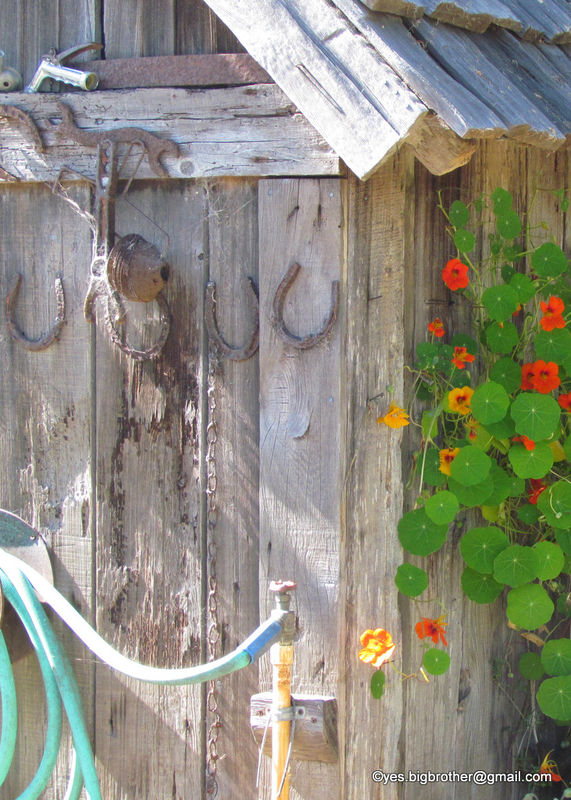
.dng at selected exposure
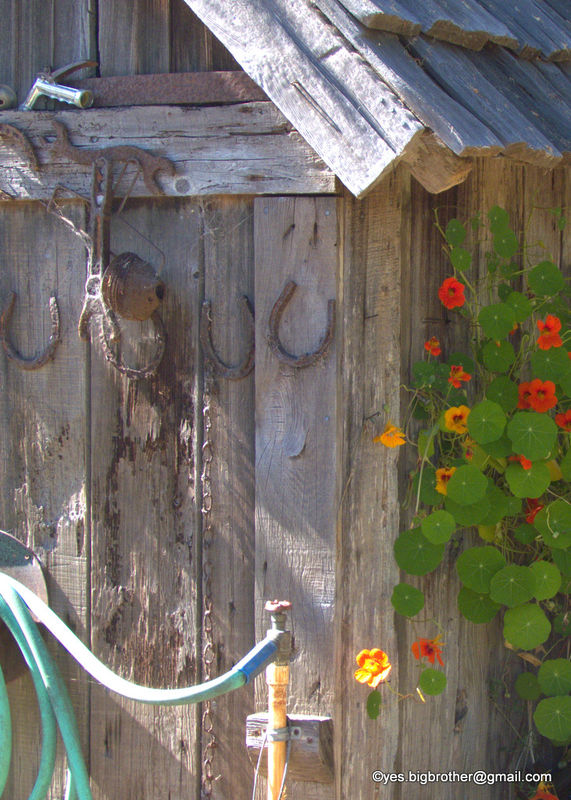
5 shot bracketed .jpg HDR
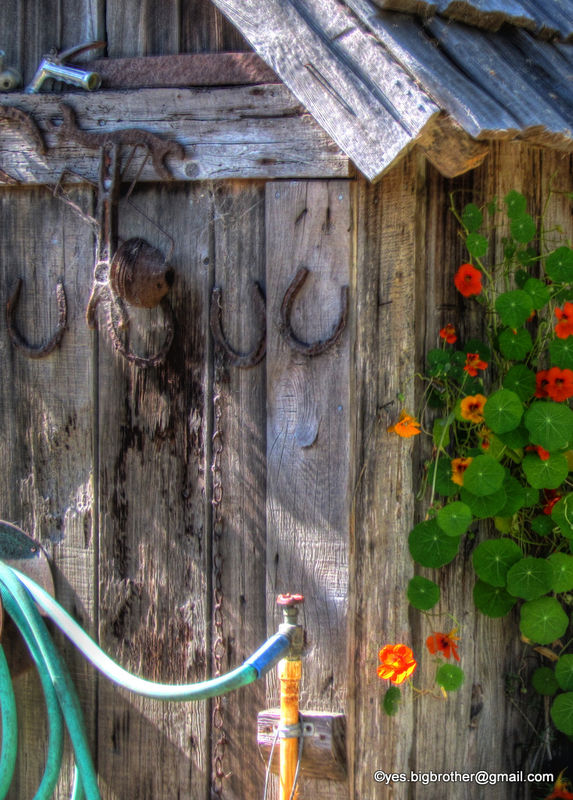
5 shot bracketed .dng HDR
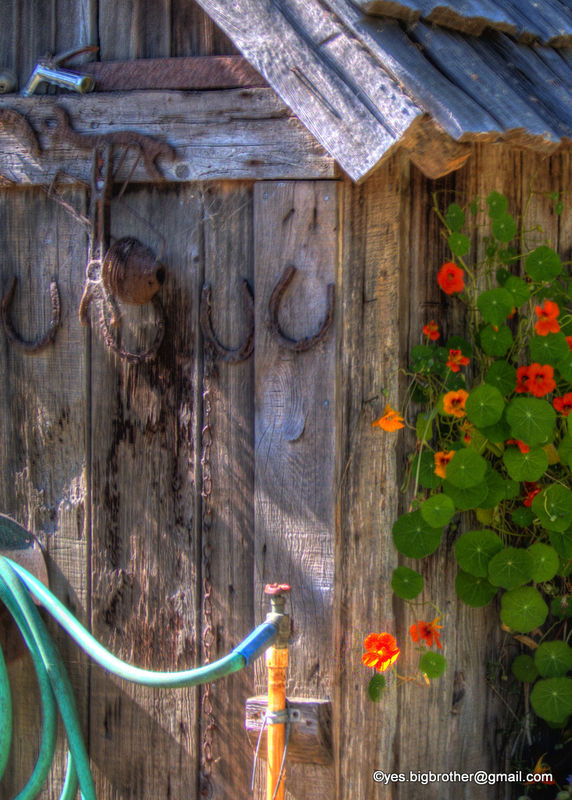
Jun 25, 2012 20:09:18 #
I think 2 and 3 are really nice shots. If you don't mind (or enjoy) the PP work I suggest you use CHDK in your SX30 to exposure bracket and merge the bracketed shots in an HDR software like Photomatix or Photoshop. If you don't want to mess around with bracketing CHDK also allows you to save RAW files (.dng) which can yield greater dynamic range in your finished photos. CHDK is so feature-rich that I use it all the time in my SX30, S3IS and SD770. For CHDK info you can search here at UHH or go to http://chdk.wikia.com/wiki/SX30. Check out the gallery on the Photomatix web site to see what it can do.